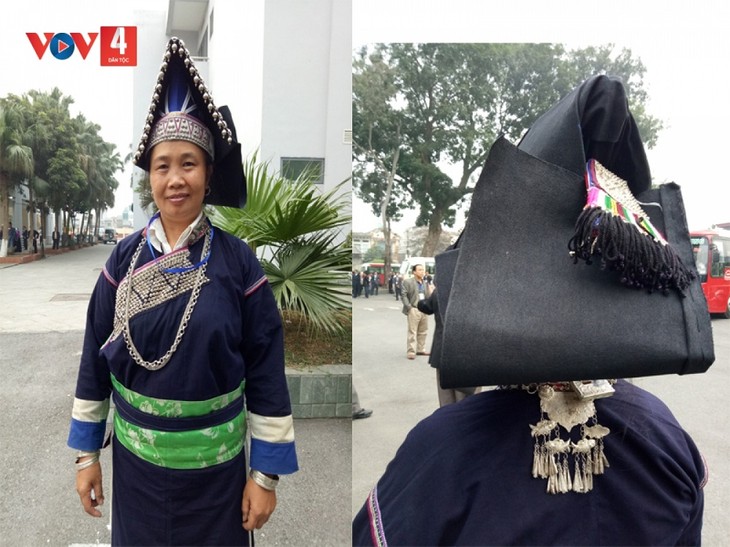(VOVWORLD) - The Pa Dí ethnic minority has a very small population, living primarily in Mường Khương district, the northern mountain province of Lào Cai. They live mainly by growing plums, pears, cardamom, tea, soybeans, corn, and rice. Their agro-forestry economy inspires Pa Di women in decorating their clothing.
 Traditional clothes of Pa Di women (Photo: VOV) Traditional clothes of Pa Di women (Photo: VOV) |
The costumes of the Pa Di are made from natural materials and dyed with indigo. The women wear long shirts of indigo fabric with split hems stretching to the ankles and buttoned on the right side. They edge the neckline and sleeves with white and blue fabric. The sides of the shirt also have white trim. The front of the shirt is decorated with small silver buttons that resemble rice grains.
“In the past our ancestors wore two-layer shirts. On the shirts, we embroider patterns representing the terraced fields. The silver buttons represent corn, rice, peanuts, beans, and other grains,” said Trang Len Din, a Pa Di woman.
Ly Seo Din, former Head of the Mass Mobilization Commission of Lao Cai province’s Party Committee, said Pa Di women represent many things by the elaborate decorations they add to their clothing.
“The clothes of the Pa Di are unique. On the front, they embroider images of terraced fields and grains. The decorative patterns show off the women’s skill and dexterity. Richer women add more silver buttons of various sizes. Some may be as large as beans or grains of corn,” said Din.
The Pa Di love nature and respect plants so, naturally, grains, fruits, and flowers are featured on their clothing.
The collar is a work of art, trimmed with pieces of blue and red fabric and decorated with two rows of beautiful silver buttons.
Around the waist is a green belt embroidered with pink, purple, and orange threads. A piece of dark green or light green cloth is sewn inside their long skirt and is only revealed when a woman is walking.
“We make all our clothes, the shirts and the pants, by hand. We sew and embroider them. At wedding and engagement ceremonies, we must wear traditional costumes,” said A Pa Di woman named Po Chin Din.
The most impressive accessory of the Pa Di woman is their roof-shaped hat. They apply several layers of beeswax to a piece of linen to make it stiff, then fold it into a roof shape. Another piece of beeswax coated linen is bent into a curved shape and attached to the roof-shaped part. The back of the curved part is decorated with pieces of silverand colorful tassels. The edge of the hat is studded with silver beads, symbolizing corn and rice grains and sufficiency.
“The roof-shaped hat symbolizes a mother’s care for her family. The hat is studded with silver beads,” Ly Seo Din said.
Before donning her hat, a Pa Di woman ties up her hair on the top of her head. The hat is then tied around her hair so she can move freely without worrying about losing it.
“The hat has many beautiful silver beads. We wear the hats at weddings and festivals,” said Po Chin Din.
The hat represents the family’s prosperity and happiness. It is a precious gift that the mother-in-law gives her daughter-in-law at her wedding. The silver beads and jewelry, such as necklaces with charms shaped like chickens and fish, represent family wealth and the love of nature.
In 2020, the Ministry of Culture, Sports and Tourism recognized the embroidered costumes of the Pa Di as a national intangible cultural heritage.